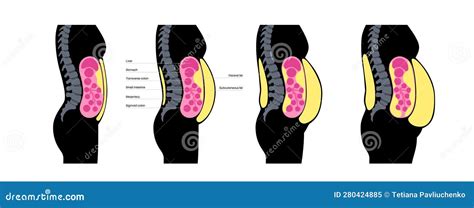The Predominant Area for Male Fat Accumulation
When it comes to fat accumulation, men often find themselves developing what is colloquially known as an ‘apple shape’ body type. This distinct pattern is characterized by a disproportionate amount of fat stored around the midsection, specifically in the abdominal area. Unlike women, who tend to store fat more readily in the hips, thighs, and buttocks (a ‘pear shape’), men’s physiology often directs excess calories to be stored centrally.

Understanding Abdominal Fat: Subcutaneous vs. Visceral
The fat that accumulates in the abdominal region can be broadly categorized into two types: subcutaneous and visceral. Subcutaneous fat is the layer you can pinch just beneath the skin. While too much subcutaneous fat can contribute to a larger waistline, it is generally considered less metabolically active and less dangerous than its counterpart.
Visceral fat, on the other hand, is the deep fat that surrounds the internal organs, including the liver, pancreas, and intestines. This type of fat is highly metabolically active and releases inflammatory substances and hormones that can negatively impact various bodily functions. It is the excessive accumulation of visceral fat that is primarily responsible for the ‘apple shape’ and its associated health concerns.

Why Men Store Fat Centrally
Several factors contribute to this male-specific fat distribution. Hormones play a significant role; testosterone, the primary male sex hormone, influences where fat is stored. While healthy testosterone levels are associated with muscle mass, declining testosterone levels (which can occur with age or lifestyle factors) can lead to increased central fat storage. Genetics also play a part, predisposing some individuals to store fat more readily in the abdomen.
Lifestyle factors, such as diet high in refined carbohydrates and unhealthy fats, lack of physical activity, chronic stress, and insufficient sleep, all contribute to the accumulation of abdominal fat. Alcohol consumption, in particular, is often linked to increased belly fat, commonly referred to as a “beer belly.”

Health Implications of the Apple Shape
The ‘apple shape’ is not merely a cosmetic concern; it is a significant indicator of potential health risks. High levels of visceral fat are strongly linked to an increased risk of serious health conditions, including:
- Cardiovascular disease (heart attacks, strokes)
- Type 2 diabetes
- Metabolic syndrome
- High blood pressure (hypertension)
- High cholesterol levels
- Certain cancers
- Sleep apnea
The inflammatory compounds released by visceral fat contribute to insulin resistance and chronic systemic inflammation, setting the stage for these chronic diseases.

Assessing Your Risk
A simple way to assess your abdominal fat is by measuring your waist circumference. For men, a waist circumference greater than 40 inches (102 cm) generally indicates a higher risk of health problems associated with excess visceral fat. This measurement, combined with other health indicators, can provide valuable insight into one’s metabolic health.

Conclusion
The accumulation of fat in the abdominal region, leading to an ‘apple shape’ body type, is a common pattern observed in men. This central fat storage, particularly visceral fat, is influenced by genetics, hormones, and lifestyle choices. Recognizing this pattern and understanding its health implications is crucial for maintaining long-term well-being and mitigating the risks of associated chronic diseases.




